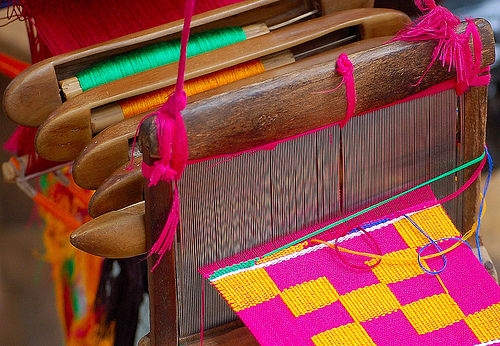The history of fabrics and textile trade used for traditional African costumes and dress has translated over the years into contemporary fashion styles that reflect modern day lifestyles in many parts of Africa.
The background of African wax print fabrics can be traced back to the Dutch merchants through to the traditional artisans of Indonesian java prints, eventually weaving its way down the West African coast via trade into the cultural wear of local Africans. These prints are now ‘part and parcel’ of our local-wear, so much so that there is virtually no separation between fabric and wear. The definition of African fashion is intricately tied to the use of these African fabrics, which stem from European manufacturers, the most predominant European and market player to date is Vlisco Dutch wax. In recent times there have been local African fabric print companies with mass popularity like Ghana’s Akosombo textiles, Nigeria’s Davida and Ivorian Woodin, though local markets are being flooded with cheaper Chinese imitations.
African textiles like the kente cloth (also known as aso-oke in Nigeria), cotton Dutch wax prints, and the use of materials like swiss lace, have always featured strongly in the history of cultural dress for many Africans and peoples of African heritage and descent worldwide. These fabrics were popularly made into traditional garments, for religious wear, traditional events, weddings and funerals, by dressmakers and seamstresses but in recent years African textiles, especially prints, have played a key role in the development of global fashion. The use of African prints for everyday, modern wear in contemporary styles has taken off and been incorporated into the mainstream and even more recently, into fashion culture on the high-street and on high fashion and couture catwalks. Its current popularity spans fashion cities like London, Milan, Paris, Japan as well as staple African cities like Accra, Lagos, Johannesburg and Dakar.
Anna Wintour coated in ‘tribal’ Burberry at the fashion shows, was an image broadcast around the world. As Editor-in-Chief of American Vogue, her ‘on trend’ African print inspired coat choice legitimized and validated the print trend, sending its popularity into Traditional textiles in Contemporary fashion…
African textiles like the kente cloth (also known as aso-oke in Nigeria), cotton Dutch wax prints, and the use of materials like swiss lace, have always featured strongly in the history of cultural dress for many Africans and peoples of African heritage and descent worldwide. These fabrics were popularly made into traditional garments, for religious wear, traditional events, weddings and funerals, by dressmakers and seamstresses but in recent years African textiles, especially prints, have played a key role in the development of global fashion. The use of African prints for everyday, modern wear in contemporary styles has taken off and been incorporated into the mainstream and even more recently, into fashion culture on the high-street and on high fashion and couture catwalks. Its current popularity spans fashion cities like London, Milan, Paris, Japan as well as staple African cities like Accra, Lagos, Johannesburg and Dakar.
Anna Wintour coated in ‘tribal’ Burberry at the fashion shows, was an image broadcast around the world. As Editor-in-Chief of American Vogue, her ‘on trend’ African print inspired coat choice legitimized and validated the print trend, sending its popularity into Traditional textiles in Contemporary fashion…
African textiles like the kente cloth (also known as aso-oke in Nigeria), cotton Dutch wax prints, and the use of materials like swiss lace, have always featured strongly in the history of cultural dress for many Africans and peoples of African heritage and descent worldwide. These fabrics were popularly made into traditional garments, for religious wear, traditional events, weddings and funerals, by dressmakers and seamstresses but in recent years African textiles, especially prints, have played a key role in the development of global fashion. The use of African prints for everyday, modern wear in contemporary styles has taken off and been incorporated into the mainstream and even more recently, into fashion culture on the high-street and on high fashion and couture catwalks. Its current popularity spans fashion cities like London, Milan, Paris, Japan as well as staple African cities like Accra, Lagos, Johannesburg and Dakar.
Anna Wintour coated in ‘tribal’ Burberry at the fashion shows, was an image broadcast around the world. As Editor-in-Chief of American Vogue, her ‘on trend’ African print inspired coat choice legitimized and validated the print trend, sending its popularity into fashion stratosphere. The past collections of couturiers like Christian Lacroix, Oscar De La Renta and Jean Paul Gaultier have regularly paid homage to tribal influences, accents that have gathered momentum in recent seasons trickling down to become a staple in mass fashion retail brands such as H&M, and online stores like ASOS Africa.

Kente Cloth Weaving – credit wwwkenteclothnet
Leave a Reply